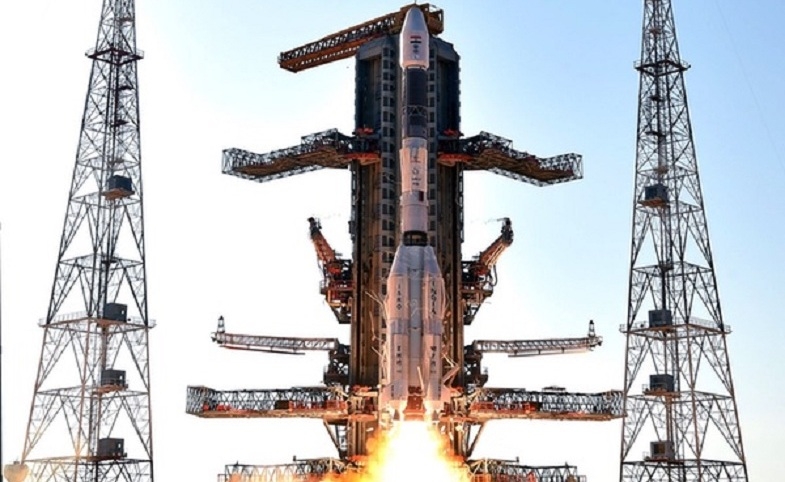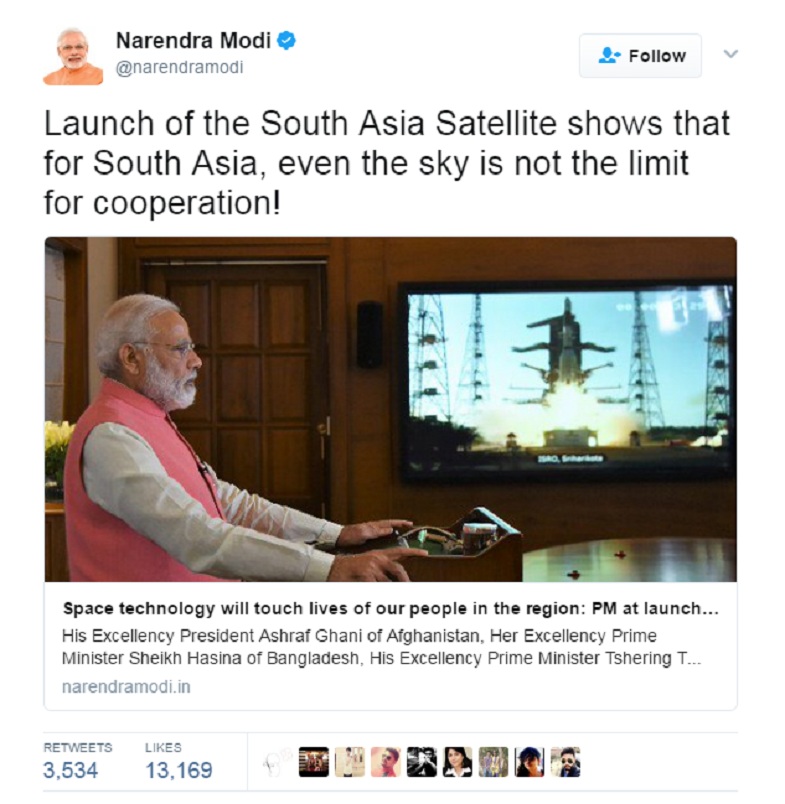It would seem impossible for the Taliban to get good publicity in Western media, but the unthinkable nearly happened on December 16, 2014. How? The Taliban tricked the press by using a powerful communications technique: the...
KEEP READINGThe CPD Blog is intended to stimulate dialog among scholars and practitioners from around the world in the public diplomacy sphere. The opinions represented here are the authors' own and do not necessarily reflect CPD's views. For blogger guidelines, click here.

Integrating India’s “Neighborhood-First” Strategy into the South Asia Satellite
India’s space diplomacy got a major boost last month with the launch of the South Asia Satellite, envisaged in June 2014 by Indian Prime Minister Narendra Modi as “India’s gift” to the South Asian Association for Regional Cooperation (SAARC). The prime minister’s vision was to increase regional cooperation among SAARC countries by leveraging India’s capabilities in space technology. The satellite was launched by the Indian Space Research Organization (ISRO) on May 5, 2017.
Significance of the South Asia Satellite
The satellite is intended to support communication, broadcasting and Internet services, disaster management, telemedicine, tele-education, and weather forecasting in the whole of South Asia. Afghanistan, Bangladesh, Bhutan, the Maldives, Nepal, and Sri Lanka, along with India, stand to benefit from it and have welcomed the initiative, while Pakistan, acting as expected, aligned with its raison d'être of opposing India and opted out of this partnership. Most importantly, the satellite may achieve the objective of maintaining strategic ties with neighbors by catering to their economic requirements.
The South Asia satellite is funded entirely by India with the intention of benefitting all eight SAARC member countries. The launch represents India “walking the talk” and making a difference to the region using its abilities, successes, and resources. India’s success in space technology is commendable, and its stature as a serious player in space technology is already established. Also, India’s science and technology workforce have the reputation as being among the best in the world. South Asia now stands to benefit from the gains that India has made in these two areas, hopefully ushering in a new era of regional cooperation.
Immediately after the launch, Narendra Modi tweeted:

From Attraction to Influence
The launch of the South Asia satellite represents a wonderful integration of India’s “neighborhood-first” strategy with its traditional strengths and desired narrative. India is dominant in South Asia, but ironically the most pressing issues facing the country are those in its very neighborhood! This is true even though South Asia is culturally very close to the Indian nation-state. Surely, India’s story needs something more in addition to the current narratives that overwhelmingly focus on India’s culture, heritage, or economic promise, and it looks like the launch of the satellite provides the Indian public diplomacy necessary to create that.
One of the biggest gripes among certain areas in the region is the perception of India as a bully. Will this launch be considered an attempt by India to assert its dominance?
For the longest time, the narrative shaped by India’s established policy focused on “attraction” attributes like Indian culture and heritage. I have argued in the past for the need to move the needle and adopt “influence” attributes if India wants to project power and be perceived as a serious geopolitical player. Influence attributes that could work in South Asia include foreign aid, bilateral cooperation, leveraging Indian media conglomerates, non-state actors, and dominance in the sphere of ideas. It would be fantastic if India’s successes could be viewed as South Asia’s successes. This region has a population of 1.6 billion and presents an opportunity for India to lead these masses to realize their potential and move towards better lives. India’s achievements in human resources, governance, science and technology, media, and defense are great examples for the emerging world to emulate.
Speaking at the South Asian Association for Regional Cooperation (SAARC) summit in 2014, India’s Prime Minister Narendra Modi echoed this sentiment when he said,
“Nowhere in the world are collective efforts more urgent than in South Asia; and, nowhere else is it so modest. Big and small, we face the same challenges - a long climb to the summit of development. But, I have great belief in our boundless potential…
“India's gift of a satellite for the SAARC region will benefit us all in areas like education, telemedicine, disaster response, resource management, weather forecasting and communication.”
Challenges Ahead
A few years from now, when the world looks back at the launch of the South Asia satellite, it should vindicate India’s position and strengthen India’s story. The policy establishment would do well to plan for certain perception challenges such as:
-
One of the biggest gripes among certain areas in the region is the perception of India as a bully. Will this launch be considered an attempt by India to assert its dominance?
-
Pakistan and China. How are they interpreting the satellite, and how will they project it? I am sure the foreign policy and public diplomacy establishment in India have anticipated this and would be ready to counter it. I also hope they have factored in the Indian agenda which should be consistently maintained on this topic.
-
The successes of the South Asia satellite need to be shared aggressively, especially using digital media, and ideally would spark the same interest that is generated when the media reports on inspiring space projects like the Mars Rover. These projects may not be similar, but stories of effort and impact should generate tremendous interest.
The South Asia satellite is a significant development in India’s quest to lead South Asia towards progress and development. As Prime Minister Narendra Modi said after the launch, “With this launch we have started a journey to build the most advanced frontier of our partnership. With its position high in the sky, this symbol of South Asian cooperation would meet the aspirations of economic progress of more than 1.5 billion people in our region and extend our close links into outer space.”
Photos (from top to bottom): Photo courtesy of the Indian Space Research Organization, Photo courtesy of Madhurjya Kotoky via Twitter
Visit CPD's Online Library
Explore CPD's vast online database featuring the latest books, articles, speeches and information on international organizations dedicated to public diplomacy.
POPULAR ARTICLES
-
November 3
-
November 5
-
November 13
-
November 25
-
November 17
Join the Conversation
Interested in contributing to the CPD Blog? We welcome your posts. Read our guidelines and find out how you can submit blogs and photo essays >.













